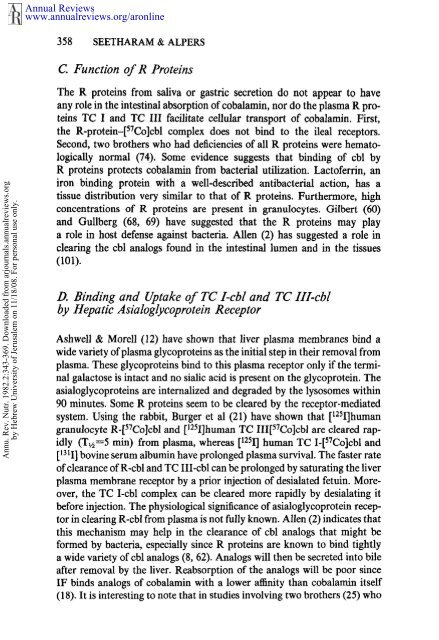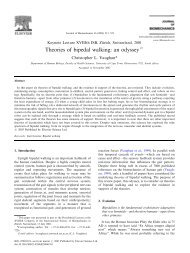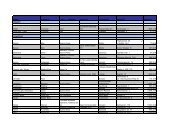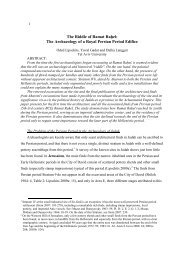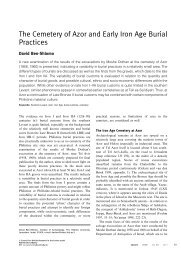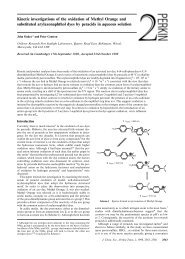Absorption and Transport of Cobalamin (Vitamin B12)
Absorption and Transport of Cobalamin (Vitamin B12)
Absorption and Transport of Cobalamin (Vitamin B12)
Create successful ePaper yourself
Turn your PDF publications into a flip-book with our unique Google optimized e-Paper software.
Annual Reviewswww.annualreviews.org/aronline358 SEETHARAM & ALPERSC. Function <strong>of</strong> R ProteinsAnnu. Rev. Nutr. 1982.2:343-369. Downloaded from arjournals.annualreviews.orgby Hebrew University <strong>of</strong> Jerusalem on 11/18/08. For personal use only.The R proteins from saliva or gastric secretion do not appear to haveany role in the intestinal absorption <strong>of</strong> cobalamin, nor do the plasma R proteinsTC I <strong>and</strong> TC III facilitate cellular transport <strong>of</strong> eobalamin. First,the R-protein-[STCo]cbl complex does not bind to the ileal receptors.Second, two brothers who had deficiencies <strong>of</strong> all R proteins were hematologicallynormal (74). Some evidence suggests that binding <strong>of</strong> cblR proteins protects cobalamin from bacterial utilization. Lact<strong>of</strong>errin, aniron binding protein with a well-described antibacterial action, has atissue distribution very similar to that <strong>of</strong> R proteins. Furthermore, highconcentrations <strong>of</strong> R proteins are present in granulocytes. Gilbert (60)<strong>and</strong> Gullberg (68, 69) have suggested that the R proteins may playa role in host defense against bacteria. Allen (2) has suggested a rolecleating the cbl analogs found in the intestinal lumen <strong>and</strong> in the tissues00~).D. Binding <strong>and</strong> Uptake <strong>of</strong> TC I-cbl <strong>and</strong> TC III-cblby Hepatic Asialoglycoprotein ReceptorAshwell & Morell (12) have shown that liver plasma membranes bindwide variety <strong>of</strong> plasma glycoproteins as the initial step in their removal fromplasma. These glycoproteins bind to this plasma receptor only if the terminalgalactose is intact <strong>and</strong> no sialic acid is present on the glycoprotein. Theasialoglycoproteins are internalized <strong>and</strong> degraded by the lysosomes within90 minutes. Some R proteins seem to be cleared by the receptor-mediatedsystem. Using the rabbit, Burger et al (21) have shown that [125I]humangranulocyte R-[STCo]cbl <strong>and</strong> [J25I]human TC III[57Co]cbl are cleared rapidly(Tw=5 min) from plasma, whereas [1251] human TC I-[57Co]cbl <strong>and</strong>[131I] bovine serum albumin have prolonged plasma survival. The faster rate<strong>of</strong> clearance <strong>of</strong> R-cbl <strong>and</strong> TC III-cbl can be prolonged by saturating the liverplasma membrane receptor by a prior injection <strong>of</strong> desialated fetuin. Moreover,the TC I-cbl complex can be cleared more rapidly by desialating itbefore injection. The physiological significance <strong>of</strong> asialoglycoprotein receptorin clearing R-cbl from plasma is not fully known. Allen (2) indicates thatthis mechanism may help in the clearance <strong>of</strong> cbl analogs that might beformed by bacteria, especially since R proteins are known to bind tightlya wide variety <strong>of</strong> cbl analogs (8, 62). Analogs will then be secreted into bileafter removal by the liver. Reabsorption <strong>of</strong> the analogs will be poor sinceIF binds analogs <strong>of</strong> cobalamin with a lower affinity than cobalamin itself(18). It is interesting to note that in studies involving two brothers (25)


